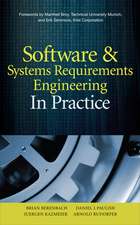MySQL Database Usage & Administration
Autor Vikram Vaswanien Limba Engleză Paperback – 16 dec 2009
Take your MySQL skills to the top tier
Maximize every powerful feature available in MySQL 5.1 with hands-on instruction from a MySQL expert. This definitive guide shows you how to use MySQL's advanced suite of data management tools, optimize performance and reliability, and secure and administer a robust RDBMS. MySQL Database Usage & Administration includes detailed code examples in each chapter to highlight real-world applications of the material covered. If you want to get the most out of MySQL, you need this practical handbook.- Understand MySQL's features, technical architecture, subsystems, and commands
- Make database design decisions that optimizre performance, storage, and reliability
- Write complex queries using joins, subqueries, and views
- Group SQL statements into transactions and execute them atomically
- Build and use sophisticated stored procedures and functions
- Automate database operations with triggers and scheduled events
- Import and export data in different formats, includiong SQL, CSV, and XML
- Optimize server and query performance
- Administer a secure, high availability MySQL RDBMS
- Manage users and control access
- Perform database maintenance, replication, backup, and recovery
Preț: 309.18 lei
Preț vechi: 386.47 lei
-20% Nou
Puncte Express: 464
Preț estimativ în valută:
59.16€ • 61.93$ • 48.95£
59.16€ • 61.93$ • 48.95£
Carte disponibilă
Livrare economică 15-29 martie
Preluare comenzi: 021 569.72.76
Specificații
ISBN-13: 9780071605496
ISBN-10: 0071605495
Pagini: 368
Dimensiuni: 185 x 231 x 18 mm
Greutate: 0.62 kg
Editura: McGraw Hill Education
Colecția McGraw-Hill
Locul publicării:United States
ISBN-10: 0071605495
Pagini: 368
Dimensiuni: 185 x 231 x 18 mm
Greutate: 0.62 kg
Editura: McGraw Hill Education
Colecția McGraw-Hill
Locul publicării:United States
Cuprins
Part I: Usage;Chapter 1. An Introduction to MySQL;Chapter 2. Understanding Basic Commands;Chapter 3. Making Design Decisions;Chapter 4. Using Joins, Subqueries, and Views;Chapter 5. Using Transactions;Chapter 6. Using Stored Procedures and Functions;Chapter 7. Using Triggers and Scheduled Events;Chapter 8. Working with Data in Different Formats;Chapter 9. Optimizing Performance;Part II: Administration;Chapter 10. Performing Basic Server Administration;Chapter 11. Managing Users and Controlling Access;Chapter 12. Performing Maintenance, Backup, and Recovery;Chapter 13. Replicating Data;Appendix A. Installing MySQL and the Sample Database;Index























